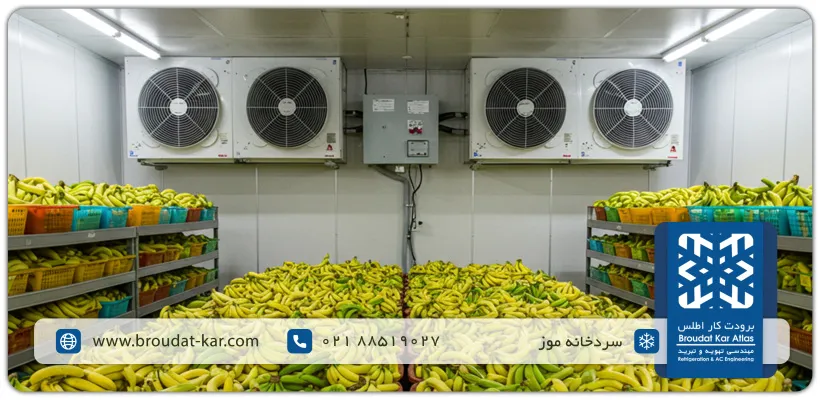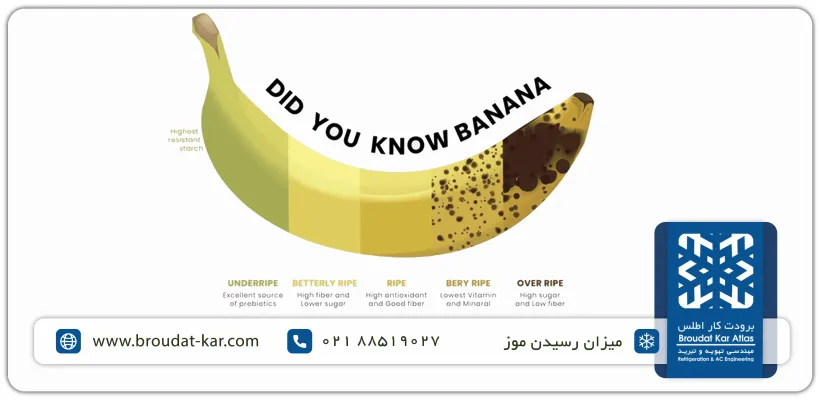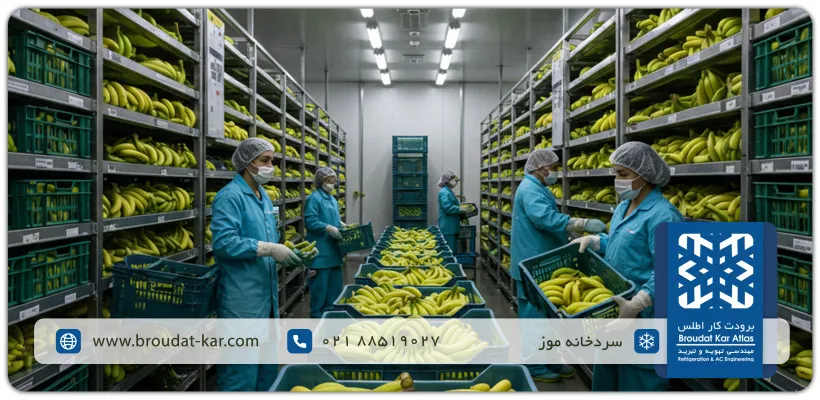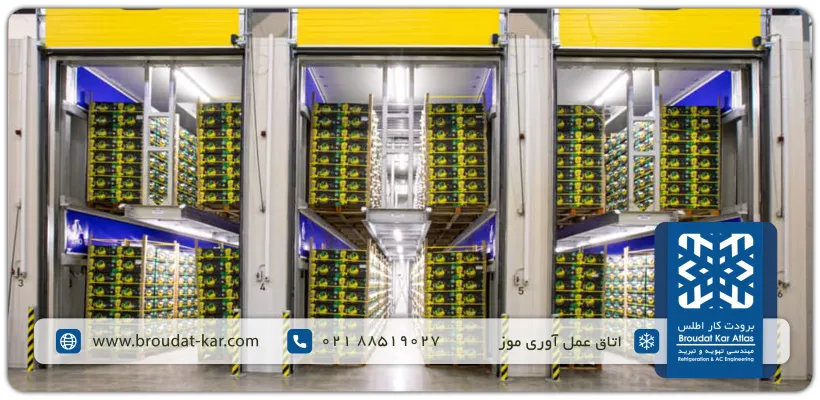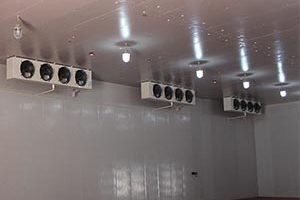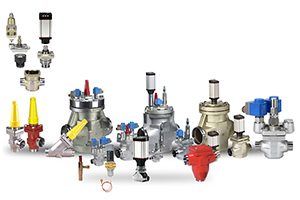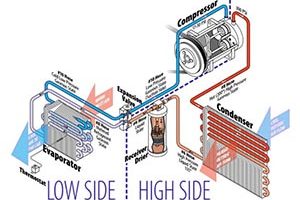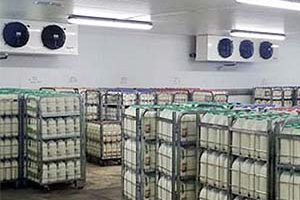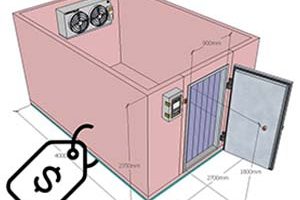It may be hard to believe, but according to the Food and Agriculture Organization (FAO) report on December 11, 2024, bananas are the fourth most consumed and important crop in the world, after wheat, rice, and corn.
This tropical fruit is cultivated in over 135 countries worldwide, including Iran, and global production reaches approximately 105 million tons per year.In Iran alone, over 250,000 tons of bananas are produced annually, mainly in provinces such as Sistan and Baluchestan and Hormozgan.
However, post‑harvest banana storage poses a major challenge due to the fruit’s high perishability and its specific temperature requirements.If bananas are not stored in a standard banana cold room, their delicate nature can lead to significant losses for producers.Proper banana cold storage not only prevents fruit spoilage but also facilitates the export of this tropical fruit to international markets.
What Is a Banana Cold Room and Why Is It Essential?
In simple terms, a banana cold room is an environment where all the proper conditions in terms of temperature, humidity, lighting, and air circulation are provided to store bananas for a long period (4 to 6 weeks). In general, there are two types of banana cold rooms: one is for storing green and unripe bananas, and the other is for ripening green bananas and turning them into yellow bananas for the fruit and vegetable market.
But why is using a banana cold room important?
- If we want bananas to reach consumers in a healthy condition after harvest, they must be stored in their dedicated cold room.
- Exporting this fruit and generating revenue depends on proper storage and standard conditions in the banana cold room.
- Because bananas are delicate, mobile cold rooms, such as containerized cold storage, must also be used for transportation to other cities.
Although using a banana cold room is very important, if it is not designed and built to standard, the results can be the opposite. For this reason, companies with extensive experience in cold room production prioritize modern equipment and engineering principles. Atlas Refrigeration Co. also considers this point and sets up various types of fruit cold rooms in different capacities with top quality and cost‑effective solutions.
You can order a cold room based on the type of refrigerant (ammonia or HFC), the type of product, and your preferred conditions. If you need free and professional consultation, Atlas Refrigeration Co. experts are available online every day of the week to assist you.
Standard Conditions for Storing Green Bananas in a Cold Room
Since bananas are tropical and delicate fruits, the cold room temperature for green bananas must be maintained between 13 and 14°C, and the relative humidity should be kept between 85% and 90%. Any temperature or humidity outside this range can increase the risk of drying, spoilage, or even premature ripening of the fruit. Although these are standard storage conditions for bananas in cold rooms, the exact values may vary slightly depending on the banana variety and the environmental conditions of the cold room.
Standard Conditions for Storing Bananas in a Ripening Cold Room
Unripe green bananas are first kept in special ripening cold rooms before entering regular banana cold storage. In these rooms, gases such as ethylene and banana gas are used to stimulate the ripening process.
The storage temperature in a ripening cold room is different from that of green banana storage. The table below shows the recommended temperatures for different stages of banana ripening:
| Optimal Temperature (°C) | Banana Ripening Stage |
| 20 _ 18 | Initial ripening |
| 28 _ 25 | Active ripening to accelerate the process |
| 25 _18 | Color change from green to yellow |
Common Problems in Banana Ripening Cold Rooms
During the banana ripening process, several serious challenges may arise. However, these issues can be easily managed with proper methods and the right equipment. The table below highlights some of the most common problems in banana ripening cold rooms, along with their causes and solutions:
| Solutions | Causes | Problem |
| Humidity control, smart ventilation, proper spacing between boxes | Humidity above 95%, poor air circulation, tightly packed banana boxes | Mold and rot |
| Pre‑cooling bananas, gradual temperature adjustment, use of fast‑acting doors | Sudden temperature changes, rapid transfer from warm environment to cold room | Blackening or softening of bananas (temperature shock) |
| Special fans, proper box stacking, ethylene concentration control with sensors | Uneven ethylene gas distribution, improper box arrangement, no gas monitoring | Uneven ripening in the room |
| Temperature & humidity control, avoid sudden changes, use proper packaging | Poor temperature and humidity control, sudden changes, improper packaging | Banana drop (quality loss after cold storage) |
Types of Banana Cold Rooms by Design and Capacity
Currently, Atlas Refrigeration Co. designs and manufactures various types of banana cold rooms according to your needs, which include:
- Industrial Cold Room:
This type of cold room is used for large‑scale, high‑capacity banana storage (typically over 200 tons). In some cases, warehouse‑style cold rooms are used for temporary bulk banana storage. - Containerized Cold Room:
If you plan to export bananas or transport them to other cities, a containerized cold room compatible with various types of trucks is the ideal choice.
Difference Between Imported and Domestic Banana Cold Storage
Imported and domestic bananas have significant differences in storage methods, which are mainly due to transportation distance and harvest conditions. Imported bananas, having traveled long distances, require special storage conditions to extend shelf life. This makes them more sensitive to temperature shocks, and they require a pre‑cooling stage before being placed in cold storage. Additionally, their ripening process takes longer and ethylene treatment must be carried out more carefully to achieve the desired color.
In contrast, domestic bananas reach the cold room faster and rarely require pre‑cooling, which results in a shorter ripening process. These differences in storage highlight the importance of precise temperature and environmental control for both types to maintain their quality and freshness.
Advantages of Banana Cold Rooms
The key benefits of using different types of banana cold rooms include:
- Reduced fruit waste
- Maintained banana quality
- Extended shelf life of bananas
- Enabling banana export opportunities
- Increased profitability of banana harvests
- Ability to ripen green and unripe bananas
Stages of Banana Preparation and Removal from Cold Storage
In summary, the process of preparing and transferring bananas to cold storage involves the following steps:
1‑ Harvesting Unripe Bananas
Bananas are usually harvested green (approximately 75% ripe) because fully yellow and ripe bananas have very limited storage life in cold rooms, although harvesting yellow bananas also occurs. In general, unripe bananas are packed and stored in the cold room immediately after harvest.
2‑ Storage in the Banana Cold Room
At this stage, bananas are stored in the cold room for a specific period. Care must be taken during stacking to avoid damaging the stems, as any injury can accelerate spoilage. It is also recommended to store bananas in ventilated wooden or plastic crates arranged in horizontal rows. Each bunch should be separated from the others so that if one banana spoils, it does not affect the rest.
3‑ Banana Ripening and Color Change
After storage, the bananas are prepared for delivery to stores or transportation to other cities. However, before shipment, green (unripe) bananas are placed in cartons inside refrigerated containers (containerized cold rooms) at 13°C and then transferred to the ripening cold room to begin the ripening process.
In the ripening cold room, after ethylene gas treatment and the ripening process, the bananas remain for three to four days depending on their initial condition and the ripeness required by the customer. They are then ready to be delivered to markets and other cities.
Difference Between Banana Cold Rooms and Other Fruit Cold Rooms
Each type of fruit requires specific conditions for cold storage. For example, green bananas must be stored at a temperature of 13 to 14°C with 90% relative humidity, while apricots require a temperature of 0°C and 95% relative humidity.
For more information about the storage conditions of various fruits, you can visit the Fruit Cold Room page on the official Atlas Refrigeration Co. website.
Equipment Required for Green Banana Cold Rooms and Banana Ripening Rooms
The following equipment is generally used in all types of banana cold rooms:
- Insulation: The best insulation for banana cold rooms is polyurethane sandwich panels, which are lightweight and highly resistant.
- Compressor: The type of compressor depends on the size of the cold room and the refrigerant used. Small cold rooms typically use hermetic or semi‑hermetic compressors, while large cold rooms use open‑type screw or piston compressors.
- Condenser: Common options include air‑cooled, water‑cooled, and evaporative condensers.
- Evaporator: Usually made of aluminum or copper, and its design depends on the fruit type and the target storage temperature.
- Humidifier: The best option for banana storage is an ultrasonic humidifier.
- Other Equipment: Electrical control panel, cold room doors, lighting system, ventilation system, and temperature & humidity control system.
However, there are differences in the equipment requirements for banana ripening rooms versus green banana cold rooms. The table below shows the specific equipment for each type:
| Specific Equipment Required | Type of Cold Room |
| Temperature: 13 to 14°C | Green Banana Cold Room |
| Relative humidity: 85% to 90% | |
| Slow circulation fans | |
| Sealed doors | |
| 10cm insulated walls | |
| Temperature: 15 to 18°C | Banana Ripening Room |
| Relative humidity: 90% to 95% | |
| Ethylene injection and control system | |
| Stronger fans | |
| Fast acting doors | |
| Special insulation |
Banana Cold Room Pricing
The cost of a banana cold room depends on several factors, including the type and number of components and their brands, storage capacity, geographical location, cold room dimensions, and installation costs such as piping and insulation.
For a customized and cost‑effective banana cold room, simply contact the Atlas Refrigeration Co. team through the official website. Our experts will provide professional consultation to help you set up a cold room that meets your exact needs without unnecessary expenses.
Buying a Banana Cold Room
When purchasing a banana cold room, it is important to consider the credibility and expertise of the manufacturer. Does the company comply with international standards? Has it obtained all the necessary certifications?
The proven track record of the Atlas Refrigeration Co. specialist team in building various banana cold rooms in Tehran and other cities ensures complete confidence in the quality of our solutions.
All Atlas banana cold room equipment comes with a one‑year warranty and is sourced from world‑renowned brands such as Danfoss and Bitzer.
Additionally, throughout the entire purchasing process, you can benefit from free professional consultation and 24/7 support every day of the week. Atlas Refrigeration Co. is committed to providing cost‑effective, high‑quality services to our valued customers nationwide.
Final Thoughts
It is safe to say that a banana cold room is the most effective method for storing bananas and increasing profitability. However, one critical challenge remains: the standard execution of the cold room. Even the smallest mistake in design or construction can result in irreversible losses.
Are you ready to make a smart investment in banana storage and export?
To get started, contact Atlas Refrigeration Co. consultants today.
Some key challenges include bananas becoming overripe, underripe, or bruised. These issues can all be prevented with proper control and adjustment of temperature, relative humidity, and ventilation.
To minimize waste, it’s recommended to use automated monitoring systems, advanced ventilation, and up-to-date equipment.
These compact cold rooms are commonly used in fruit markets and wholesale produce centers. They are equipped with temperature and humidity control systems to ensure proper preservation.
Related posts
Banana Cold Room
Valves and Control Devices in Ammonia and Freon Refrigeration Systems The variety of valves and control devices in refrigeration systems
Cold Storage Equipment Cold storage equipment encompasses a variety of machines and devices specifically designed to store perishable goods at
What is Fruit Cold Storage? A Fruit cold storage is a specialized facility designed to store fruits and vegetables
What is Industrial Cold store? An industrial cold store is a large-scale facility designed and constructed to preserve and
Cold Room Price Estimation – Year 2024 At Atlas Refrigeration, we recognize the pivotal role cold rooms play in diverse
